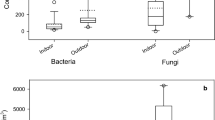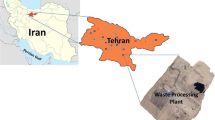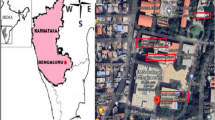Abstract
Ambient levels of viable bioaerosol were measured at four different sites on the campus of Jawaharlal Nehru University (JNU), New Delhi, India. Most of the viable bioaerosol was associated with the fungal fraction with the remainder due to bacteria. The highest concentrations of fungi were found at a health center (1,293 cfu/m3). The highest concentrations of both gram-positive (338.8 cfu/m2) and gram-negative (614 cfu/m2) bacteria were found at a garbage dump site. Gram-negative bacteria were found in larger numbers than gram-positive, possibly due to the higher ambient temperatures during their sampling. Most of the fungal bioaerosol identified is associated with immunotoxic diseases such as sick building syndrome and allergic diseases and was found in respirable fractions. Since the bacterial fractions were identified on the basis of morphology, i.e. only to the level of genus, their relationship to health effects could not be established. Although most of the sampling occurred indoors in naturally ventilated buildings, external temperature and humidity did not vary significantly during the study. Thus, it is more likely that the types of organisms and levels observed had more to do with the sources (decomposing garbage, spores carried from wooded areas, etc.) than the ambient or indoor environmental conditions.





Similar content being viewed by others
References
ACGIH (1989) Step two: on-site investigation, 1–8; Fungi, 1–10; Bacteria, 1–7. Committee on bioaerosols. In: Guidelines for the assessment of bioaerosols in the indoor environment. American Conference of Governmental Industrial Hygienists, Cincinnati, OH
ATS (American Thoracic Society) (1990) Diagnostic standards and classification of tuberculosis. Am Rev Respir Dis 142(3):725–735
Andersen AA (1958) New sampler for the collection, sizing, and enumeration of viable airborne particles. J Bacteriol 76:471–484
Bacteriological Analytical Manual (1998) 8th edn, revision A
Baron EJ, Finegold SM (1990) Bailey & Scott’s diagnostic microbiology, 8th edn. The C.V. Mosby Company, St. Louis, pp 76, 79, 82, 100–126, 133
Breathnach AS, de Ruiter A, Holdworth GM, Bateman NT, O-Sullivan DG, Rees PJ (1998) An outbreak of multi-drug resistant tuberculosis in a London teaching hospital. J Hosp Infect 39:11–17
Burge HP, Boise JR, Rutherford JA, Solomon WR (1977) Comparative recoveries of airborne fungus spores by viable and non-viable modes of volumetric collection. Mycopathologia 61(1):27–33
Cox CS, Wathes CM (1995) Bioaerosols in the environment. Bioaerosols handbook. Lewis, Boca Raton, pp 11–14
Douwes J, Thorne P, Pearce N, Heederik D (2003) Bioaerosol health effects and exposure assessment: progress and prospects. Ann Occup Hyg 47:87–200
Eddleman H (2005) Bacteria media from potato. Ph.D. thesis. www.disknet.com/indiana
Hameed A, Awad A (2007) Airborne dust, bacteria, actinomycetes and fungi at a flourmill. Aerobiologia 23:59–69
http://www.airqualitydirect.com/store/index.cfm?page=bioaerosols
http://www.pollutionissues.com/Ho-Li/Indoor-Air-Pollution.html
Kirmeyer GJ, Foust GW, Pierson GL, Simmler JJ, Le Chevalier MW (1993) Optimizing Chloramine Treatment. Denver, American Water Works Research Foundation
Kool JL, Bergmire-Sweat D, Butler JC, Brown EW, Peabody DJ, Massi DS (1999) Hospital characteristics associated with colonization of water systems by Legionella and risk of nosocomial legionnaires disease: a cohort study of 15 hospitals. Infect Control Hosp Epidemiol 20:798–805
Leopold SS (1988) “Positive hole” statistical adjustment for a two-stage, 200-hole-per-stage Andersen air sampler. Am Ind Hyg Assoc 49(2):A88–A90
Macher JM (1989) Positive-hole correction of multiple-jet impactors for collecting viable microorganisms. Am Ind Hyg Assoc J 50(11):561–568
Macher J, Ammann HA, Burge HA, Milton DK, Morey PR (1999) Bioaerosols: assessment and control. American Conference of Governmental Industrial Hygienists, Cincinnati, pp 1–5
Meteorological Parameters (2010) Centre for studies on regional development (CSRD), JNU, New Delhi 2010, daily weather data
Mohr AJ (2002) Fate and transport of microorganisms in air, Chapter 74. Manual of environmental microbiology, 2nd ed In: Hurst CJ, Crawford RL, Knudsen G, McInerney M, Stetzenbach LD, (eds), ASM Press, Washington DC, pp 827–38
Reinthaler FF, Marth E, Eibel U, Enayat U, Feenstra O, Friedl H, Kock M, Semmelrock FPP, Pridnig G, Schlacher R (1997) The assessment of airborne microorganisms in large-scale composting facilities and their immediate surroundings. Aerobiologia 13:167–175
Riordan TG, Smaldone GC (2004) Respiratory medical societies and the threat of bioterrorism. Thorax 59:265–267
Smith EG (1990) Sampling and identifying allergenic pollens and molds. Blewstone Press 15, San Antonio, pp 41–49
Stetzenbach LD (2005) Bacteriology of air, Topley and Wilsons microbiology and microbial infections: bacteriology-I, 10th edn. In: Borriello PS, Murray PR, Funke G (eds) ASM Press, Washington, DC, pp 185–194
Stetzenbach LD, Buttner MP, Cruz P (2004) Detection and enumeration of airborne biocontaminants. Curr Opin Biotechnol 15:170–174
Traeger MS, Wiersma ST, Rosenstein NE, Malecki JM, Shepard CW, Raghunathan PL (2002) First case of bioterrorism-related inhalational anthrax in the United States, Palm Beach County, Florida, 2001. Emerg Infect Dis 8:1029–1034
Wang CC, Fang GC, Kuo CH (2010) Bioaerosols as contributors to poor air quality in Taichung City, Taiwan. Environ Monit Assess 166:1–9
Acknowledgments
Authors acknowledge the contributions of the anonymous reviewer and editor for their help in improving the quality of this manuscript. Thanks to Himanshu Lal and Rajesh Kushwaha for their help during sampling and analysis. Individuals who gave permission for and assisted in the sampling phase of the work are also thanked.
Author information
Authors and Affiliations
Corresponding author
Rights and permissions
About this article
Cite this article
Srivastava, A., Singh, M. & Jain, V.K. Identification and characterization of size-segregated bioaerosols at Jawaharlal Nehru University, New Delhi. Nat Hazards 60, 485–499 (2012). https://doi.org/10.1007/s11069-011-0022-3
Received:
Accepted:
Published:
Issue Date:
DOI: https://doi.org/10.1007/s11069-011-0022-3




